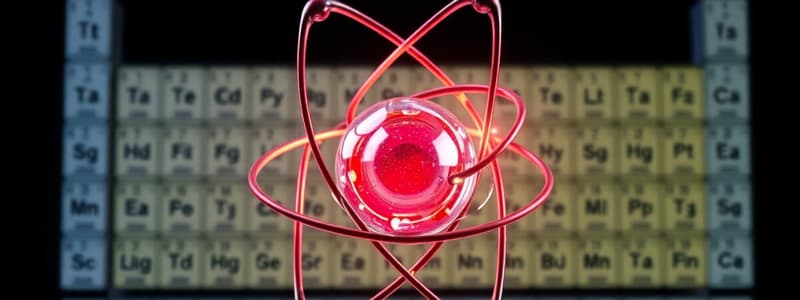Podcast
Questions and Answers
What defines the mass number of an atom?
What defines the mass number of an atom?
- Total number of protons and neutrons (correct)
- Number of protons in an atom
- Total number of protons and electrons
- Number of neutrons in an atom
Which type of bond involves the sharing of electrons between atoms?
Which type of bond involves the sharing of electrons between atoms?
- Covalent Bonding (correct)
- Metallic Bonding
- Ionic Bonding
- Electrostatic Bonding
What does Le Chatelier's Principle state regarding systems at equilibrium?
What does Le Chatelier's Principle state regarding systems at equilibrium?
- Changes in temperature have no effect on equilibrium.
- It will shift in response to changes in external conditions. (correct)
- It will always favor the formation of products.
- The concentration of reactants and products remains constant.
Which of the following statements is true regarding acids and bases?
Which of the following statements is true regarding acids and bases?
What do ionic bonds primarily involve?
What do ionic bonds primarily involve?
In terms of reaction speed, which factor does NOT significantly affect the reaction rate?
In terms of reaction speed, which factor does NOT significantly affect the reaction rate?
What represents the chemical process in which an acid and a base react to form a salt and water?
What represents the chemical process in which an acid and a base react to form a salt and water?
Which branch of chemistry deals specifically with carbon-containing compounds?
Which branch of chemistry deals specifically with carbon-containing compounds?
Flashcards are hidden until you start studying
Study Notes
Basics of Chemistry
- Definition: Study of matter, its properties, composition, and changes.
- Branches:
- Organic Chemistry: Study of carbon-containing compounds.
- Inorganic Chemistry: Study of inorganic compounds.
- Physical Chemistry: Study of the physical properties and behavior of molecules.
- Analytical Chemistry: Techniques for analyzing substances and their compositions.
Atomic Structure
- Atom: Basic unit of matter.
- Subatomic Particles:
- Protons: Positive charge, found in nucleus.
- Neutrons: No charge, found in nucleus.
- Electrons: Negative charge, found in electron cloud.
- Atomic Number: Number of protons in an atom.
- Mass Number: Total number of protons and neutrons.
Periodic Table
- Arrangement: Elements arranged by increasing atomic number.
- Groups: Vertical columns, similar chemical properties (e.g., alkali metals, halogens).
- Periods: Horizontal rows, energy levels of electrons.
Chemical Bonding
- Ionic Bonding: Transfer of electrons from one atom to another.
- Covalent Bonding: Sharing of electrons between atoms.
- Metallic Bonding: Delocalized electrons in a metal lattice.
Stoichiometry
- Mole Concept: A mole is 6.022 x 10²³ particles.
- Molar Mass: Mass of one mole of a substance.
- Balanced Chemical Equations: Same number of each type of atom on both sides.
Thermodynamics
- First Law: Energy cannot be created or destroyed, only transformed.
- Enthalpy (ΔH): Heat change at constant pressure.
- Entropy (ΔS): Measure of disorder or randomness in a system.
Kinetics
- Reaction Rate: Speed at which reactants are converted to products.
- Factors Affecting Rate:
- Concentration of reactants.
- Temperature.
- Surface area.
- Catalyst presence.
Equilibrium
- Dynamic Equilibrium: Rates of forward and reverse reactions are equal.
- Le Chatelier's Principle: System at equilibrium will shift in response to changes in concentration, temperature, or pressure.
Acids and Bases
- Definitions:
- Acids: Proton donors (H⁺).
- Bases: Proton acceptors (OH⁻).
- pH Scale: Measures acidity or alkalinity (0-14 scale).
- Neutralization Reaction: Acid + Base → Salt + Water.
Redox Reactions
- Oxidation: Loss of electrons.
- Reduction: Gain of electrons.
- Oxidizing Agent: Substance that gains electrons.
- Reducing Agent: Substance that loses electrons.
Organic Chemistry
- Hydrocarbons: Compounds composed of carbon and hydrogen.
- Alkanes: Single bonds (saturated).
- Alkenes: At least one double bond (unsaturated).
- Alkynes: At least one triple bond (unsaturated).
- Functional Groups: Specific groups of atoms that determine chemical properties (e.g., alcohols, carboxylic acids).
Practical Applications
- Laboratory Techniques: Titration, chromatography, spectroscopy.
- Safety Measures: Proper use of PPE, understanding Material Safety Data Sheets (MSDS).
Important Concepts to Review
- Molecular Geometry: VSEPR theory, shapes of molecules.
- Solubility Rules: Guidelines for predicting solubility of ionic compounds in water.
- Gas Laws: Boyle's, Charles's, and Ideal Gas Law (PV=nRT).
Basics of Chemistry
- Chemistry involves the study of matter, its attributes, composition, and transformations.
- Major branches include:
- Organic Chemistry: Focus on carbon-based compounds.
- Inorganic Chemistry: Covers inorganic substances.
- Physical Chemistry: Examines molecular physical properties and behaviors.
- Analytical Chemistry: Techniques for substance composition analysis.
Atomic Structure
- An atom serves as the fundamental unit of matter.
- Subatomic particles within atoms include:
- Protons: Positively charged, located in the nucleus.
- Neutrons: Neutral charge, also in the nucleus.
- Electrons: Negatively charged, found in the electron cloud around the nucleus.
- The atomic number indicates the number of protons in an atom.
- Mass number refers to the total count of protons and neutrons in an atom.
Periodic Table
- Elements are systematically arranged by increasing atomic number.
- Groups signify vertical columns, with elements sharing similar chemical properties, such as alkali metals and halogens.
- Periods identify horizontal rows, correlating to electron energy levels.
Chemical Bonding
- Ionic bonding arises from the transfer of electrons between atoms.
- Covalent bonding involves the sharing of electrons among atoms.
- Metallic bonding features delocalized electrons within a metal lattice structure.
Stoichiometry
- A mole consists of 6.022 x 10²³ particles.
- Molar mass measures the mass of one mole of a substance.
- Balanced chemical equations ensure equal numbers of each atom type on either side of the equation.
Thermodynamics
- The First Law posits that energy cannot be generated or destroyed, only transformed.
- Enthalpy (ΔH) measures heat change at constant pressure.
- Entropy (ΔS) quantifies disorder or randomness within a system.
Kinetics
- Reaction rate indicates the velocity at which reactants convert into products.
- Factors influencing reaction rates include:
- Concentration of reactants.
- Temperature changes.
- Surface area available for reaction.
- Presence of catalysts.
Equilibrium
- Dynamic equilibrium occurs when forward and reverse reaction rates equalize.
- Le Chatelier's Principle asserts that an equilibrium system will adjust to counteract changes in concentration, temperature, or pressure.
Acids and Bases
- Acids function as proton donors (H⁺), while bases act as proton acceptors (OH⁻).
- The pH scale ranges from 0 to 14, indicating acidity or alkalinity.
- A neutralization reaction results in the formation of salt and water from an acid and a base.
Redox Reactions
- Oxidation involves the loss of electrons, while reduction entails the gain of electrons.
- An oxidizing agent gains electrons, and a reducing agent loses electrons.
Organic Chemistry
- Hydrocarbons consist solely of carbon and hydrogen elements.
- Types include:
- Alkanes: Feature single bonds (saturated).
- Alkenes: Contain at least one double bond (unsaturated).
- Alkynes: Have at least one triple bond (unsaturated).
- Functional groups are specific atom groups that influence chemical behaviors, such as alcohols and carboxylic acids.
Practical Applications
- Key laboratory techniques encompass titration, chromatography, and spectroscopy.
- Essential safety measures include proper personal protective equipment (PPE) usage and familiarity with Material Safety Data Sheets (MSDS).
Important Concepts to Review
- Molecular geometry is described by VSEPR theory, outlining the shapes of molecules.
- Solubility rules assist in predicting how ionic compounds dissolve in water.
- Gas laws, including Boyle's, Charles's, and the Ideal Gas Law (PV=nRT), relate to gas behavior under various conditions.
Studying That Suits You
Use AI to generate personalized quizzes and flashcards to suit your learning preferences.




